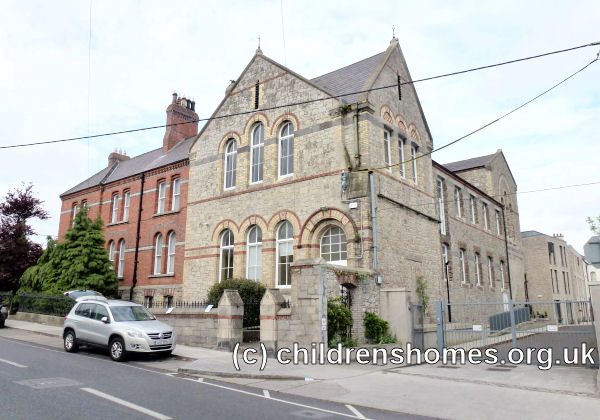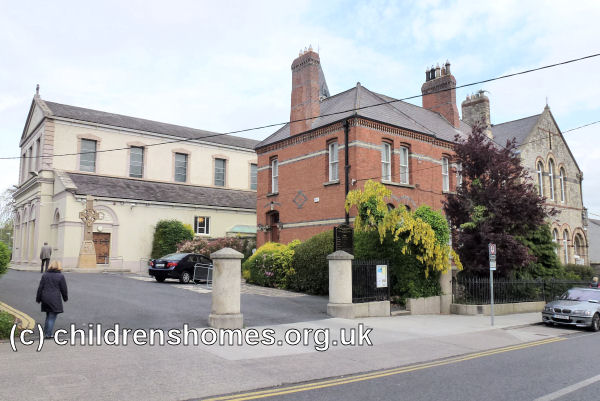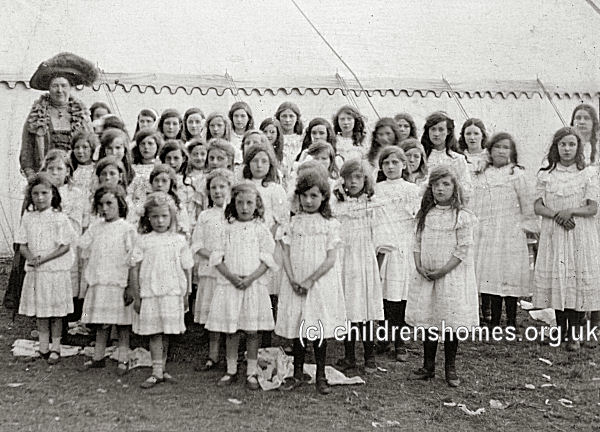St Anne's Industrial School, Booterstown, Dublin, Republic of Ireland
St Anne's Industrial School for Roman Catholic Girls was founded in 1870 by the Sisters of Mercy. It was located at Booterstown Avenue, Booterstown, about six miles to the south-east of Dublin, initially occupying temporary premises that were certified to commence operation on 10 November 1870.
An inspection in 1872 recorded that 113 girls were under detention at the institution, plus one voluntary inmate. A further 74 children attended the National schools at the site. Building work for the Industrial School and for an adjoining presbytery, was now largely complete, both sections being designed by the Dublin architect John Loftus. Robinson. As well as school rooms and dormitories, a dairy had been fitted up, and their were plans for a proper laundry to be built. Some land had also been procured for use of the inmates. The official capacity of the School was set at 134 places. The girls' industrial training included needlework, machine work, housework, cooking, and washing, and dairy management. The institution was managed by Mrs Alice Keenan and a staff of seven Sisters of Mercy. The National schools were attended by the great majority of the children of the neighbourhood who were taught reading, writing, dictation, arithmetic, grammar, geography, drawing, and singing (Hullah's method).

Former St Anne's Industrial School, Booterstown, 2014 © Peter Higginbotham

Church of the Assumption, Presbytery and Industrial School, Booterstown, 2014 © Peter Higginbotham
Construction of the new laundry was completed in 1874. That year's inspection noted that girls of 'superior ability' (then numbering 30), intended for National teachers and governesses, were instructed in instrumental music and drawing. Industrial training comprised needlework in all its branches, plain and fancy work, machine work, lace making of every description, and the making of artificial flowers. The girls were instructed in dressmaking, cooking, housework, the care of pigs and poultry, milking, and the making of butter. They also worked in the garden and laundry
In 1875, a second laundry was erected where washing for private families was done by the girls, who were thus taught to make up fine linen. White marble slabs had been put up in the lavatory to replace timber, as being found to be cleaner and more tidy than wood. Gymnastic poles were erected in the exercising grounds. Mrs Mary J. Forde now had charge of the School, with a staff of six Sisters of Mercy, assisted by seven paid officers, including a well qualified dressmaker.
In July and August 1877, a violent epidemic of measles attacked the girls in the school but no deaths resulted. In 1878, a number of cases of small-pox occurred amongst the inmates, leading the inspector to suggest that the sanitary condition of the School were not good. He also expressed the opinion that the farmyard was the worst of any Industrial School in Ireland, with its small amount of farmland also being inadequate for training the girls in dairy management.
In 1881, a play hall was erected for recreational use by the girls in wet weather. The poultry yard was also enlarged during the year. Charge of the institution had new been resumed by Mrs Alice Keenan. The following year it was recorded that the elder children cut out and made all the clothing worn in the school. They made shirts and underclothing for the public,and knitted silk stockings to order. They did fancy work, fretwork, leather work, embroidery, crochet, macrâmé, point and other laces. They worked in the laundry, and make up fine linen for private families. They milked cows, made good butter, cared for poultry, and worked in the garden. They learned cookery and the duties of domestic servants. Girls whose terms of detention had expired but whose training was not sufficient to enable them to find good situations were transferred to the House of Mercy in Baggot-street, until fitted for employment as teachers or servants.
In May 1895, the Sisters of Mercy opened the St Mary's Industrial School at Blackrock. Eighty girls were transferred to Blackrock from Booterstown, whose capacity was then reduced to 54 places. Mrs Keenan also moved to take charge of the new school and was succeeded at Booterstown by Mrs S. Grace. In 1897, Mrs Grace was replaced by Mrs K. O'Keefe.
When the Blackrock school was closed in December 1901, 26 of its inmates were transferred to Booterstown, whose official capacity was increased to 80 places.

Countess of Aberdeen with choir of St Anne'sIndustrial School, Booterstown, date unknown © Peter Higginbotham
An inspection in 1911 recorded the number of committed inmates as 86, with 16 girls out on licence. The schoolrooms and dormitories were noted as being heated by open fires and gas stoves. In the classroom, performance in singing, recitation, grammar and mental arithmetic was rated as 'good', while geography ranged from 'fair' to 'good'. Cookery classes are taught by a certificated teacher. Other industrial training included laundry work, housewifery, needlework, and nursery and cottage care. There was daily physical drill and exercises with bar-bells, dumb-bells, cymbals and Indian clubs. The girls also learned step-dancing. The manager was now Mrs M. Bertrand, assisted by four Sisters of Mercy, four assistant teachers, a teacher of domestic science, cook, laundress, and sewing mistress. By the following year, Mrs M. C. Griffin had taken over as manager.
The School was still in operation in the 1970s.
Records
Note: many repositories impose a closure period of up to 100 years for records identifying individuals. Before travelling a long distance, always check that the records you want to consult will be available.
- Mercy Congregational Archives, Catherine McAuley Centre, 23 Herbert Street, Dublin 2, D02 HD68, Ireland.
Bibliography
- Arnold, Mavis, and Laskey, Heather Children of the Poor Clares (2004, Appletree Press)
- Barnes, Jane Irish Industrial Schools 1868-1908 (1989, Irish Academic Press)
- Dunne, Joe The Stolen Child: A Memoir (2003, Marion Books)
- Rafferty, Mary and O'Sullivan, Eoin Suffer the Little Children: The Inside Story of Ireland's Industrial Schools (1999, New Island Books)
- Touher, Patrick Fear of the Collar: Artane Industrial School — My Extraordinary Childhood (1991, O'Brien Press)
- Tyrrell, Peter and Whelan, Diarmuid Founded on Fear: Letterfrack Industrial School (2006, Irish Academic Press)
- Wall, Tom The Boy from Glin Industrial School (2015, Tom Wall)
Links
- Glencree Reconciliation Centre (former Reformatory site)
- The Commission to Inquire into Child Abuse
Except where indicated, this page () © Peter Higginbotham. Contents may not be reproduced without permission.


